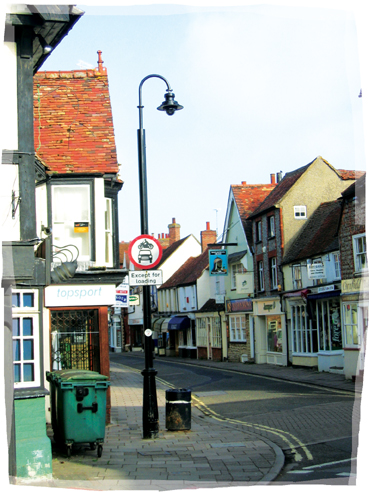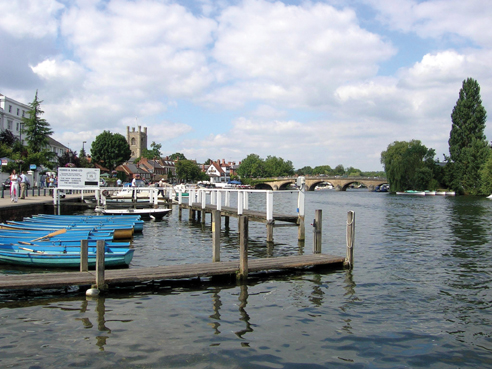During the last two decades the growth of CCTV cameras on the streets has exceeded all expectations.
The demand for the installation of equipment and the urgency of this demand have often been secondary to any consideration for the locale into which the cameras are installed.
This has led to many buildings being blighted by large cumbersome surveillance assemblies. This article discusses the problems and recent developments.
By Chris Newman
|

|
|
The town of Thame in Oxfordshire, one of the most historic towns in the UK, has been using CCTV cameras that are matching to the surroundings.
(Photo by Conway Security Products) |
Technological progress has meant that the size of camera installations has shrunk considerably but blending the CCTV system into something that appears to be part of the surrounding structural fabric is a challenge that has rarely been met. The UK¡¯s major cities have seen massive regeneration over the past ten years and architecture has become an area of public enthusiasm, the interest fuelled in part by mass-audience television programmes showing project restorations.
With these new attitudes has come an awareness that CCTV equipment which is out of sympathy with historical architecture can do a lot more than spoil a tourist¡¯s photograph; it can undermine the aesthetic integrity of a whole neighbourhood.
The role of architects and urban planners in the installation and approval of CCTV surveillance is becoming more and more significant since conscientious professionals do not want their carefully designed environments disfigured by overt security assemblies hanging off the side of attractive historic buildings. What is acceptable on an industrial estate will not be tolerated in a Victorian civic building for example.
DESIGN REQUIREMENTS
The diversity of aesthetic requirements even in a single city means that an out-of-the-box solution is not viable. Simply having products that are considered intrinsically ¡®attractive¡¯ will make them look at home on some buildings but they will be every bit as unsightly as a standard unit in other environments.
With ¡®listed¡¯ architecture in the UK now being as recent as the ¡®red brick¡¯ universities of the 1970s, security consultants are being asked to specify equipment that is visually appropriate for buildings ranging from pure geometric abstractions through to the pantiles of say Regency Bath or Brighton, with the Art Deco streamlining of the Hoover Building in west London somewhere in between.
Aesthetic control over historic buildings, streets and public areas needs to be effective if authentic atmospheres are to be maintained. Obviously a company that manufactures dome assemblies and pan and tilt housings from raw materials at a UK base is going to be well placed to take an intelligent brief and respond with designs that fulfill the technical specifications of urban planners, architects and security consultants as well as their time frames. Even minor modifications to a standard item can allow a housing or dome to complement a facade or merge with decorative elements. Matching design to the environment can be a delicate balancing act and a manufacturer who is buying in components from another continent will never be able to react effectively to system design requirements as they change.
|

|
With architecturally-sensitive use of surveillance units, the civic landscape need not be threadbare.
(Photo by Conway Security Products)
|
AESTHETIC CHALLENGES
The potential intrusiveness of security equipment is most important for planners when they consider the visual impact of historic buildings. But it is crucial in any public space. Installers and manufacturers must work to ensure that surveillance technology does not intimidate users of a facility and that the privacy of those who work at the site is respected. Hospitals will always be a stumbling block in so far as access to certain areas has to be restricted and yet those excluded should not feel unduly snubbed. Legitimate visitors must never be made to feel unwelcome and medical staff perhaps specialists from an auxiliary wing and therefore unknown to guards may need urgent access.
System specifiers and architects should also bear in mind that so-called "aesthetic" challenges are rarely only aesthetic. Often the visual difficulties encountered by security professionals are the result of poor overall planning on the part of architects and facility managers. A well-known New York tower complex -- which might best remain nameless -- provides a textbook example. Incredibly, the logistics of access control and visitor surveillance were factored in not only after structural design but after the building was occupied. Planners and designers who had laboured over the grandeur of a flagship reception were horrified when facility managers, who were complying with safety requirements and brooked no argument, cordoned off large sections of the main portal in order to install access control units. The equipment not only took from the aesthetic impact of the entrance but caused worker and visitor bottlenecks at the start and end of the day.
THE BEAUTY OF PLANNING
It is important that urban planners engaged on anything from a new-build project to refurbishment of a listed city building or historic market town, should speak to well-informed security consultants and manufacturers at an early stage. This interaction should be two-way and on-going throughout the works. But such forethought is the exception rather than the rule.
I know of only a few examples which buck this trend. The upgrading of CCTV as part of the recent redevelopment of the Old Market Square in the city of Nottingham has been achieved with minimal clutter from gantries and poles. Similarly, the restoration of the Victorian areas of Sunderland has integrated CCTV with existing structures while there has been architecturally-sensitive use of surveillance units in the King¡¯s Cross district of central London and in Grainger Town, Newcastle.
But despite the worldwide explosion of CCTV installations (expenditure in the UK alone was ¡Ì300m in 2005), few specifiers consider the environmental impact of security equipment and the effective militirisation of public spaces. This lack of planning is most notable in street lighting where overt box-shaped pan and tilts are often mounted on nineteenth-century-style lamp columns with no attempt to match the CCTV housing to its surroundings.
|

|
The town of Henley in Oxfordshire (Photo by Conway Security Products)
|
COMBINING SECURITY AND BEAUTY
A local council in Oxfordshire has been significantly using elegant domes and housings from Conway Security Products, who has invested in a ground-up design which integrates a powerful camera and dome assembly with a genuine street light. The locations include Didcot, Thame, Wallingford and Henley which is the venue for a world famous rowing regatta. The projects underline all the considerations discussed above since they are the result of close co-operation between the consultant, ITS Services, Conway, and conservation officers who made stringent demands as to schematics. Two contractors, Siemens Building Technologies and CDS Integrated Security Systems, have implemented the schemes.
Dave Sweetland of ITS Services said, ¡°All the locations are significant. Didcot is a major railway confluence while Henley, Wallingford and Thame are three of the most historic towns in the UK, abounding with listed buildings. Thame centre is significant in that many of the buildings are Tudor.¡±
And Sweetland stressed the kind of urban blight that can afflict areas where CCTV is used indiscriminately. ¡°These [the Oxfordshire] installations are the last word in refinement compared with the vast majority of projects. Visit many of the country¡¯s town centres and you¡¯re confronted with unsightly forests of gantries and camera poles. But the street fittings with the Conway domes look the part. They are tidy, smart and ornate without being fussy.¡±
Designing and producing CCTV equipment that suits its environment is always going to be a juggling act between performance and visual appeal. On the one hand if a manufacturer or installer crudely bolts a piece of ornate ironwork onto a standard unit the result will fool few people. Conversely, it makes no sense to put a standard dome inside a street light as its functionality will be compromised which defeats the primary object of the camera.
Avant-garde and ¡®signature¡¯ structures such as the London Eye and Sir Norman Foster¡¯s Swiss Tower with their bold lines can accommodate harsh CCTV columns amid modern lighting poles. But the security industry has a duty of care to the older, more fragile city and urban environment..
Chris Newman is Director of Conway Security Products (www.conway-cctv.co.uk).
For more information, please send your e-mails to swm@infothe.com.
¨Ï2007 www.SecurityWorldMag.com. All rights reserved.
|



